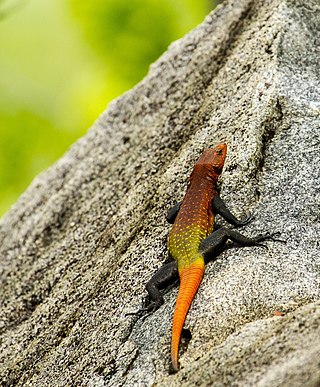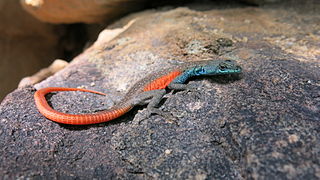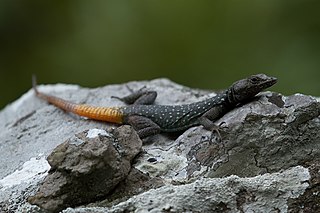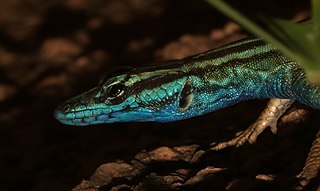
The genus Cordylus includes a wide variety of species of small to medium spiny lizards from Africa, collectively called girdle-tailed lizards or girdled lizards. All are diurnal and ovoviviparous. Most species are rupicolous (rock-dwelling), while a few species are arboreal or live in burrows. They defend themselves with osteoderms and by quickly retreating into rock crevices or burrows. Many species live in groups, and males defend territories.

Platysaurus is a genus of lizards, commonly known as flat lizards for their flat backs, in the family Cordylidae.

The Soutpansberg flat lizard is a species of lizard in the Cordylidae family.

The Waterberg flat lizard is a species of lizard in the family Cordylidae. It is endemic to South Africa.

The Cape flat lizard or Namaqua flat lizard is a lizard in the Cordylidae family found in Namibia and South Africa.
The dwarf flat lizard or lesser flat lizard is a lizard in the family Cordylidae. It is found in Southern Africa.

The emperor flat lizard or imperial flat lizard is a species of lizard in the Cordylidae family.

The common flat lizard is a species of lizard in the Cordylidae family. This lizard has 9 subspecies, all living in southern Africa.

The Lebombo flat lizard is a species of lizard in the family Cordylidae.
The orange-throated flat lizard is a species of lizard in the Cordylidae family.

The ocellated flat lizard or Chimanimani flat lizard is a species of lizard in the family Cordylidae. It is endemic to the Chimanimani Mountains of south eastern Zimbabwe and western Mozambique.

The Sekukhune flat lizard is a species of lizard in the family Cordylidae. The species is endemic to South Africa. It has two subspecies.

Platysaurus torquatus, the striped flat lizard or collared flat lizard, is a species of lizard in the Cordylidae family found in southeast Africa.

The East African armadillo lizard, dwarf sungazer, or tropical girdled lizard is a species of arboreal or rupicolous (rock-dwelling) lizard endemic to East Africa.

The Transvaal girdled lizard or Reichenow's spiny-tailed lizard is a very flattened girdled lizard from northeastern South Africa, Eswatini, and southeastern Botswana. It prefers rock outcrops in open grassland and feeds on small arthropods, especially beetles.
An isolated population of the Rhodesian girdled lizard from granite outcrops in montane grassland of northern Malawi was recently redescribed as Cordylus nyikae. Unlike the Rhodesian girdled lizard, the head shields of this species are very rugose, the nostrils are pierced in the lower posterior corner of the nasal scales, and the dorsals do not have a serrated posterior margin. The dorsal coloration is dark brown to gray-brown with lighter spots. The tail and upper lips are light brown. The belly is buff. Its common name is Nyika girdled lizard.

Pseudocordylus melanotus, also known as the common crag lizard or Highveld crag lizard, is a species of lizard found in Eswatini, Lesotho, and South Africa. Pseudocordylus subviridis is considered a distinct species by the Reptile Database, but a subspecies of Pseudocordylus melanotus by IUCN.
Donald George Broadley (1932–2016) was an African herpetologist. He described as new to science 115 species and subspecies, and 8 genera and subgenera of reptiles. He was one of the founders of the Herpetological Association of Africa. He earned his doctorate at the University of Natal in 1966. His widow, Sheila Broadley, is also a herpetologist.

Platysaurus attenboroughi is a species of lizard in the family Cordylidae. It is a small, spiny lizard found in Namibia and South Africa.

















